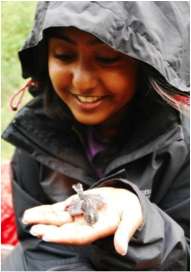Large Animal Research Group (LARG), University of Cambridge
Principal Investigator: Professor Tim Clutton-Brock, FRS
 My research group usually consists of 4-6 PhD students and 5-8 post-docs. We work at the interface between behavioural ecology, population dynamics and evolutionary biology. We currently work in three main areas:
My research group usually consists of 4-6 PhD students and 5-8 post-docs. We work at the interface between behavioural ecology, population dynamics and evolutionary biology. We currently work in three main areas:
(1) The evolution of vertebrate breeding systems
Current studies are investigating the division of labour and the evolution of cooperation in social mongooses; the evolution of leks in mammals and birds; and the functional significance of variation in parental care in fish.
(2) Population regulation and the control of population stability in large mammals
Long-term studies in red deer (on Rum), Soay sheep (on St Kilda) and suricates (southern Kalahari) are examining the ecological factors generating stability and instability in populations; the effects of early development on adult success and survival; asymmetries in competition between the sexes; and the effects of different management regimes on ungulate populations.
(3) Natural and sexual selection in natural populations
We are currently using the long-term studies of red deer and sheep to investigate selection on phenotype and genotype in natural populations; the heritability of reproductive success; and the effects of variation in population density on natural and sexual selection.
- Website: http://www.zoo.cam.ac.uk/directory/tim-clutton-brock
- Contact: thcb@cam.ac.uk
More information about current projects can be found by clicking on the group members’ names below.
Cambridge Group
 Webite: http://www.zoo.cam.ac.uk/directory/dominic-cram-1
Webite: http://www.zoo.cam.ac.uk/directory/dominic-cram-1
Contact: dc593@cam.ac.uk
Conflict and cooperation in meerkat societies: reproduction and ageing
The meerkat social life is one of extremes. While living in close groups confers certain benefits, competition can also be intensified. Cooperation and conflict are important themes in meerkat societies, and I investigate both to address two main topics:
- How do meerkats’ social lives shape their patterns of ageing? Can cooperation slow down the ageing process, or does intense conflict lead to stress and accelerated senescence? I am addressing these questions by investigating multiple markers of cellular ageing (oxidative stress, antioxidant protection and telomere dynamics).
- How do cooperation and conflict drive variation in behavior and reproduction in subordinate female meerkats?
Most female meerkats never become dominant, so there is intense selection for subordinates to maximize their breeding success. Are subordinates able to adjust the timing and development of their pregnancies, to maximize pup survival? What strategies can a female employ in the struggle to become dominant? For further information see: http://domcram.weebly.com
 Website: http://www.zoo.cam.ac.uk/directory/dr-constance-dubuc
Website: http://www.zoo.cam.ac.uk/directory/dr-constance-dubuc
Contact: cd556@cam.ac.uk
Intrasexual competition in meerkat females
I am broadly interested in the evolution of breeding systems and reproductive strategies in animals. Before joining the Kalahari Meerkat Project, my research focused on understanding the consequence of the decreased strength of direct male-male competition for breeding opportunity in anthropoid primates using Cayo Santiago rhesus macaques as a model. In meerkats, I somewhat ask the opposite question, now examining the causes and consequences of increased direct competition between females.
Females are typically expected to avoid aggressive competition because the resulting costs and stress impair both fecundity and longevity. As a result, intense food competition usually favours the evolution of breeding systems where females are spread in space, such as monogamy. But in meerkats, extreme predation risks forces social living despite limited/unpredictable food availability. As such, while meerkats live in overall peaceful social groups, in fact only one female, the dominant, accounts for almost all successful breeding attempts. My research centre on understanding what mechanisms have evolved for females to cope with the extreme competition such socio-ecological context entails, and whether and how it affects the trade-off between fecundity and longevity.
 Website: http://www.zoo.cam.ac.uk/directory/tejasvini-chalikonda
Website: http://www.zoo.cam.ac.uk/directory/tejasvini-chalikonda
Contact: c.tejasvini@gmail.com
Causes and consequences of individual differences in foraging success
An individual’s foraging behaviour is a major determinant of its growth, survival and reproductive success. The aim of my PhD research is to explore the extent and causes of individual differences in food choice, foraging success and daily weight gain and assess the consequences of these differences for juvenile and adult survival and breeding success. I answer these by addressing three main questions:
- How are individual differences related to differences in age, sex and maternal rank and whether the magnitude of these differences changes with age?
- How does early life environment such as season and number of helpers in a group at birth, maternal condition and rank and exposure to prenatal cortisol play a role in the development of an individual’s foraging success?
By conducting supplementary feed experiments, I ask how increased food during different stages of life affects an individual’s foraging skill and what the consequences of this are for its fitness. Is this strategy maintained or do meerkats alter it based on changing environmental conditions? To read more about my work and life at the KMP, visit my blog https://tejasvinichalikonda.wordpress.com
 Website: http://www.zoo.cam.ac.uk/directory/jack-thorley
Website: http://www.zoo.cam.ac.uk/directory/jack-thorley
Contact: jbt27@cam.ac.uk
Life history trade-offs in co-operative breeders
Co-operative breeders are an interesting case study for life history theory, with the apparent load-lightening effects of helpers granting reproductive individuals high levels of fecundity across unusually long lives. Yet, the high reproductive success of a select few females also creates intense competition for breeding rights. Through my meerkat work, I investigate the relative influence of helping versus competition in shaping individual life history trajectories, with particular emphasis upon sex differences in rates of ageing. (See more about Jack’s work on molerats below).
Cambridge Group - Affiliated group members
 Department of Ecology & Evolutionary Biology, University of Michigan; http://sites.lsa.umich.edu/dantzerlab/
Department of Ecology & Evolutionary Biology, University of Michigan; http://sites.lsa.umich.edu/dantzerlab/
Contact: dantzer@umich.edu
Meerkats and stress
Like many social animals, meerkats exhibit extensive individual-variation in the expression of cooperative (or helping) behaviour where some individuals exhibit consistently more cooperative behaviour than others. Meerkats also exhibit changes (plasticity) in their cooperative behaviour where they may exhibit more or less cooperation depending upon the circumstances. We are investigating how developmental experiences and stress physiology contributes to whether meerkats exhibit high or low levels of cooperative behaviour. This involves understanding what environmental factors cause stress in meerkats and assessing the consequences on their cooperative behaviour.
 Current affiliation: CNRS Researcher, Centre d’Ecologie Fonctionnelle et Evolution, Montpellier;
Current affiliation: CNRS Researcher, Centre d’Ecologie Fonctionnelle et Evolution, Montpellier;
http://www.cefe.cnrs.fr/fr/recherche/ee/esp/777-c/2673-elise-huchard
Contact: ehuchard@gmail.com
The evolution of mammalian social and mating systems
I am interested in the evolution of mammalian social and mating systems. At the interface between sexual and kin selection, a major axis of my work explores the causes and consequences of reproductive and life history strategies in mammalian societies using observational and experimental data, mostly in the context of long-term, individually-based studies. My past research has examined the evolution of sexual signals, mate choice, multiple mating (polyandry) and reproductive conflicts within and between sexes in natural populations of primates such as the Tsaobis baboons and the Kirindy lemurs.
In the Kalahari meerkats, my primary work explores the extent of social and genetic influences on development and growth trajectories using quantitative genetics and experimental approaches. Individual variation in growth is high in cooperative breeders and may reflect plastic divergence in developmental trajectories leading to breeding vs. helping phenotypes. My core questions explore the influence of social competition on the phenotypic plasticity of growth and whether individuals can strategically adjust their growth to the growth of rivals, as well as the relative importance of additive genetic variance, developmental plasticity and phenotypic flexibility in shaping the growth trajectories and cooperative propensities of individual meerkats.
 Royal Veterinary Collage, University of London
Royal Veterinary Collage, University of London
http://www.rvc.ac.uk/about/our-people/stuart-patterson#tab-research
Contact: spatterson@rvc.ac.uk
A Targeted Approach to Controlling Tuberculosis in Wild Meerkats
Whilst there may be good reasons for controlling some diseases of wildlife (e.g. zoonotic risk to people, livestock health, conservation, or welfare), achieving this is often problematic, with difficulties relating to availability of tests, knowledge of the disease transmission, and physically getting hold of enough animals. Reducing the number of animals needing to be caught would reduce costs, and increase the ease of a control programme, and so this work is looking at whether a targeted approach can work. Individuals may be more likely to transmit infections due to their social behaviours. High risk individuals theoretically make the most efficient targets for control measures. This project is investigating whether a meerkat’s risk of being infected with tuberculosis (a common, transmissible infection in the study population) is affected by the control measure applied. Two targeted vaccination strategies are being trialled: one whereby group members with the greatest number of social contacts are vaccinated, and secondly, where treatment is applied to individuals considered most likely to become infected. Individuals in these groups, and accompanying control groups are being tested regularly throughout this two year study to check on their infection status.
 Endocrine Research Laboratory, University of Pretoria, South Africa http://www2.up.ac.za/zoology/old_zoology/staff.php?person=211
Endocrine Research Laboratory, University of Pretoria, South Africa http://www2.up.ac.za/zoology/old_zoology/staff.php?person=211
Contact: jscheun@zoology.up.ac.za
Hormonal correlates of dominance structure in meerkats
Although I am interested in a variety of fields such as conservation and general ecology, my main focus lies with the study of the endocrine activity present in different species. Specifically, my work focuses on describing reproductive and stress-related hormone patterns and their effect on an individual’s behavioural, physical and physiological aspects during key life history stages. To do so I utilize non-invasive faecal hormone metabolite monitoring via the appropriate enzyme immunoassays in order to obtain robust, longitudinal hormone patterns of a species. The Kalahari Meerkat Project, in connection with the University of Cambridge, has one of the largest faecal collections in the world, totalling more than 32 000 samples. My focus during my postdoctoral fellowship is the analyses of various samples sets in order to clarify the pattern of gonadal and adrenal hormones and their role in determining important parameters such as dominance structure in the meerkat, Suricata suricatta.

